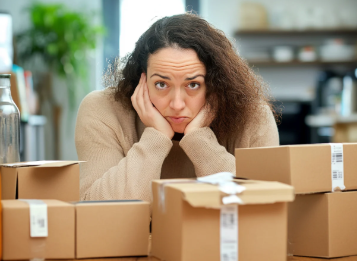Supplied Boxes vs. Self-Bought: Cost Comparison

Choosing between supplied boxes from moving companies and boxes you buy yourself might sound simple, but the difference can hit your budget hard. They are convenient since they’re delivered to your door and collected later.
Buying your own boxes, however, gives you freedom to choose sizes, materials, and quantities. You’re not stuck with strict return dates or worried about accidental damage charges.
The real question is which option saves you money while keeping your move smooth and stress-free. Let’s break it down so you can decide which one works for your timeline, wallet, and moving style.
What Are Supplied Boxes?
Supplied boxes come as part of a package from many moving companies.
Big names like Pickfords or Britannia drop them off before your move and take them away when you’re finished. These sturdy, reusable boxes are designed to handle repeated use without falling apart.
They’re especially popular in busy cities where people want to avoid last-minute errands for packing supplies.
Many moving companies even offer specialised options like wardrobe boxes with hanging rails or sectioned crates for glasses and dishes. It feels like everything is taken care of before you even lift a finger.
For anyone with a packed schedule, supplied boxes can cut out a lot of hassle. You don’t need to plan a trip to the store or spend hours assembling flat-packed cartons.
What Are Self-Bought Boxes?
Buying your own boxes means heading to stores like Homebase or Tesco or ordering online from Amazon or Argos. You get to choose from a wide range of options, from small book boxes to heavy-duty cartons for bulky furniture.
This approach gives you total control over the packing process. You decide how many you need and which sizes work best for your belongings. If you overbuy, you can save the extras for future storage or even sell them to others planning a move.
You can also explore second-hand options. Charity shops, Freecycle, and local Facebook groups often have boxes from people who’ve just moved. It’s a budget-friendly and eco-conscious way to stock up without paying full price.
Cost of Supplied Boxes
On the surface, supplied boxes can seem cost-effective. Moving companies usually charge a small fee per box each week, which quickly adds up if you need a lot of them for a longer period.
There are also delivery and collection charges to consider. These fees vary depending on where you live, and costs can rise if you’re outside the company’s main service area.
Missing the return deadline often leads to daily late fees for each box. Even a short delay can push your total costs higher than expected. It’s a reminder that while convenient, supplied boxes may come with hidden expenses if you’re not careful.
Cost of Self-Bought Boxes
Self-bought boxes tend to have a lower upfront cost. Standard cardboard cartons cost £1 to £5 each. A bulk pack of 25 medium boxes might set you back £40 to £60, and you get to keep them for future use.
Buying in bulk often comes with discounts, lowering the price per box even further. If you’re on a tight budget, second-hand boxes are an excellent option. Sites like Gumtree or Facebook Marketplace frequently list boxes for free or at a minimal cost.
While you’ll need extras like packing tape, bubble wrap, and labels, these supplies usually add just £20 to £40 to your total. Even with these additions, you’re likely to spend less than on rented supplied boxes, especially if your move stretches over several weeks.
Hidden Costs of Supplied Boxes
Supplied boxes may appear hassle-free, but there are potential pitfalls. If a box is damaged during your move, you might face repair or replacement fees of £5 or more per box.
Strict return deadlines can add pressure. Being late by a few days racks up charges quickly, particularly if you’ve rented dozens of boxes. It’s easy to lose track of time during the chaos of a move, making these fees an unwelcome surprise.
Arranging box collection can also be inconvenient. Some companies have limited pickup slots, which might mean taking time off work or rearranging plans to hand them back.
Hidden Costs of Self-Bought Boxes
Buying your own boxes comes with its own surprises. Many people underestimate how much packing materials like tape and bubble wrap cost. These extras can sneak up on you if you’re packing a whole house.
Overbuying boxes is another common issue. It’s tempting to overestimate how many you’ll need, leading to unused stacks taking up space in your new home.
Disposing of boxes after the move can also be a hassle. While many are recyclable, some may be too damaged or bulky to manage easily. Donating them to friends or local groups is one way to avoid waste and keep your home clutter-free.
Environmental Impact
Supplied boxes are designed for reuse. Many are made from recycled materials and cleaned between uses, which reduces waste. However, repeated transportation and cleaning still leave a carbon footprint.
Self-bought boxes, especially second-hand ones, are a greener option if reused multiple times. Cardboard is biodegradable and recyclable, making it a solid choice for eco-conscious movers.
Plastic storage totes are even more durable and can last through multiple moves, cutting down on waste significantly.
Choosing second-hand boxes not only saves money but also keeps materials out of landfills, giving them a second life.
Which Option Saves Time?
Supplied boxes save time because they’re delivered and collected. You don’t have to spend hours sourcing, assembling, or disposing of boxes. For busy households or those with tight deadlines, this can be a major advantage.
Self-bought boxes take more effort upfront. You’ll need time to shop around, assemble them, and dispose of or store them after. But if you start collecting early and pace your packing, this process doesn’t have to feel overwhelming.
In the end, it’s about whether you value time over flexibility.
See Also: Advanced Bookkeeping Techniques for Professionals 8329821428
Combining Both Options
Some movers find that mixing supplied and self-bought boxes gives the best results. Renting speciality boxes like wardrobes or crates for glassware provides convenience where it counts.
For everything else, using your own boxes keeps costs lower and gives you more control over packing speed. This hybrid approach balances efficiency and budget.
Planning ahead with a clear idea of what each type of box will be used for can save both time and money.
Conclusion
Choosing between supplied boxes and self-bought boxes comes down to priorities. Supplied boxes offer speed and convenience, but rental costs and strict deadlines can make them pricey.
The best option depends on your schedule, budget, and how much control you want over the packing process. A combination of both may strike the perfect balance, saving time where needed and cutting costs where possible.
By weighing short-term ease against long-term value, you can make a decision that keeps your move smooth and your budget intact.




